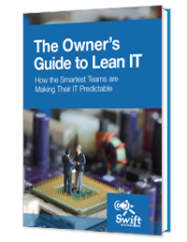
The Definitive List of IT acronyms
When you live in the world of IT, it can be tough to remember that to normal people, the acronyms we use on a daily basis aren’t exactly standard knowledge. To help, we’ve compiled this definitive list of IT acronyms to give you a head start on the language of the industry. So, without further ado, here are the acronyms to know, to help you understand and communicate in the world of IT.
What does IT stand for?
IT stands for Information Technology. It is the broad subject concerned with all aspects of managing and processing information.
What does ACK stand for?
ACK stands for Acknowledgement. In the TCP protocol, ACK is how a connection is established.
What does ACL stand for?
ACL stands for Access Control List. It specifies which users or system processes are granted access to objects, as well as what operations are allowed on given objects.
What does ADSL stand for?
ADSL stands for Asymmetric Digital Subscriber Line. It is a data communications technology that enables faster data transmission.
What does AES stand for?
AES stands for Advanced Encryption Standard. It is a specification for the encryption of electronic data.
What does ARP stand for?
ARP stands for Address Resolution Protocol. It is a telecommunication protocol used for resolution of network layer addresses.
What does ATM stand for?
ATM stands for Asynchronous Transfer Mode. It is a telecommunication concept for the carriage of a complete range of user traffic.
What does BGP stand for?
BGP stands for Border Gateway Protocol. It is a standardized exterior gateway protocol designed to exchange routing and reachability information among autonomous systems on the Internet.
What does BIOS stand for?
BIOS stands for Basic Input Output System. It is the program a personal computer’s microprocessor uses to get the computer system started after it is turned on.
What does BSS stand for?
BSS stands for Basic Service Set. It provides the basic building block of a wireless LAN and will be a single access point together with all associated stations.
What does CAT stand for?
CAT stands for category. It is commonly used to describe cables., like the Category 5 cable or CAT 5.
What does CHAP stand for?
CHAP stands for Challenge-Handshake Authentication Protocol. It authenticates a user or network host to an authenticating entity.
What does CIDR stand for?
CIDR stands for Classless Inter-Domain Routing. It is a method for allocating IP addresses and routing Internet protocol packets.
What does CIR stand for?
CIR stands for Committed Information Rate. It is the bandwidth for a virtual circuit guaranteed by an ISP to work under normal conditions.
What does CLI stand for?
CLI stands for Command-Line Interpreter. It is applied to computer programs designed to interpret a sequence of lines of text which may be entered by a user, read from a file, or another kind of data stream.
What does CPE stand for?
CPE stands for Customer Premises Equipment. It is any terminal and associated equipment located at a subscriber’s premises and connected with a carrier’s telecommunication channel at the demarcation point.
What does CPU stand for?
CPU stands for Central Processing Unit. It handles the instructions you give the computer and handles most of the calculations.
What does DDR stand for?
DDR stands for Double Data Rate. It is a class of memory integrated circuits used in computers.
What does DNS stand for?
DNS stands for Domain Name System. It is a decentralized naming system for computers, services, or any resource connected to the Internet or private network.
What does DRAM stand for?
DRAM stands for Dynamic Random Access Memory. It stores each bit of data in a separate capacitor within an integrated circuit.
What does ECC stand for?
ECC stands for Error Correction Code. It is a type of computer data storage that can detect and correct the most common kinds of internal data corruption.
What does FDD stand for?
FDD stands for Floppy Disk Drive. It is a computer disk drive that enables a user to save data to removable diskettes.
What does FPS stand for?
FPS stands for Frame Per Second. It is the frequency at which an imaging device displays consecutive images called frames.
What does FTP stand for?
FTP stands for File Transfer Protocol. It is a standard network protocol used to transfer computer files between a client and server on a computer network.
What does GB stand for?
GB stands for Gigabytes. A gigabyte is a measure of computer data storage capacity that is roughly equivalent to 1 billion bytes.
What does GDI stand for?
GDI stands for Graphical Device Interface. It is used by most Windows applications to display images on a monitor.
What does HDLC stand for?
HDLC stands for High-Level Data Control Level. It is used almost exclusively to connect one device to another using Asynchronous Balanced Mode.
What does HTTP stand for?
HTTP stands for Hyper Text Transfer Protocol. It is the foundation of data communication for the World Wide Web.
What does ICMP stand for?
ICMP stands for Internet Control Management Protocol. It is used by network devices to send error messages or relay query messages use it.
What does IP stand for?
IP stands for Internet Protocol. It is the principle communications protocol in the Internet Protocol suite for relaying datagrams across network boundaries.
What does LAN stand for?
LAN stands for Local Area Network. It is a computer network that interconnects computers within a limited area.
What does MAC stand for?
MAC stands for Media Access Control. It is the lower sublayer of the data link layer of the seven-layer OSI model.
What does MB stand for?
MB stands for Megabytes. A megabyte is a multiple of the unit byte for digital information.
What does MEM stand for?
MEM stands for Memory.
What does NAC stand for?
NAC stands for Network Access Control. It is an approach to computer security that attempts to unify endpoint security technology.
What does NIC stand for?
NIC stands for Network Interface Card. It is a computer hardware component that connects a computer to a computer network.
What does PPP stand for?
PPP stands for Point-to-Point Protocol. It is a data link protocol used to establish a direct connection between two nodes.
What does RAM stand for?
RAM stands for Random Access Memory. It is a form of computer data storage that allows items to be accessed in almost the same amount of time irrespective of the physical location of the data inside the memory.
What does SFTP stand for?
The SFTP protocol’s main purpose is to transfer data, but it is also used to obtain general access to the FTP server’s file system. The SFTP protocol runs on a secure channel – no clear text passwords or file data are transferred.
What does SSH stand for?
SSH stands for Secure Shell. It is a cryptographic network protocol operating at layer 7 of the OSI model to allow login and other network services to operate securely over an unsecured network.
What does TB stand for?
TB stands for Terabyte. It is a measure of computer storage capacity that is 2 to the 40th power, or approximately a trillion bytes.
What does VDC stand for?
VDC stands for Video Display Controller. It means including related links, information, and terms.
What does VLAN stand for?
VLAN stands for Virtual Local Area Network. It is any broadcast domain that is partitioned and isolated in a computer network at the data link layer.

IT systems are foundational to modern businesses. Too often, that foundation is unsteady. Unpredictable outages, insecure networks, and unreliable performance from mission-critical systems can jeopardize your entire business.
There’s a better way. Learn how.
Get in touch with us for a free consultation with one of our technical experts. We’ll review your current systems, assess your needs, and identify the coverage options to best meet them.
Get in touch with us by phone:

